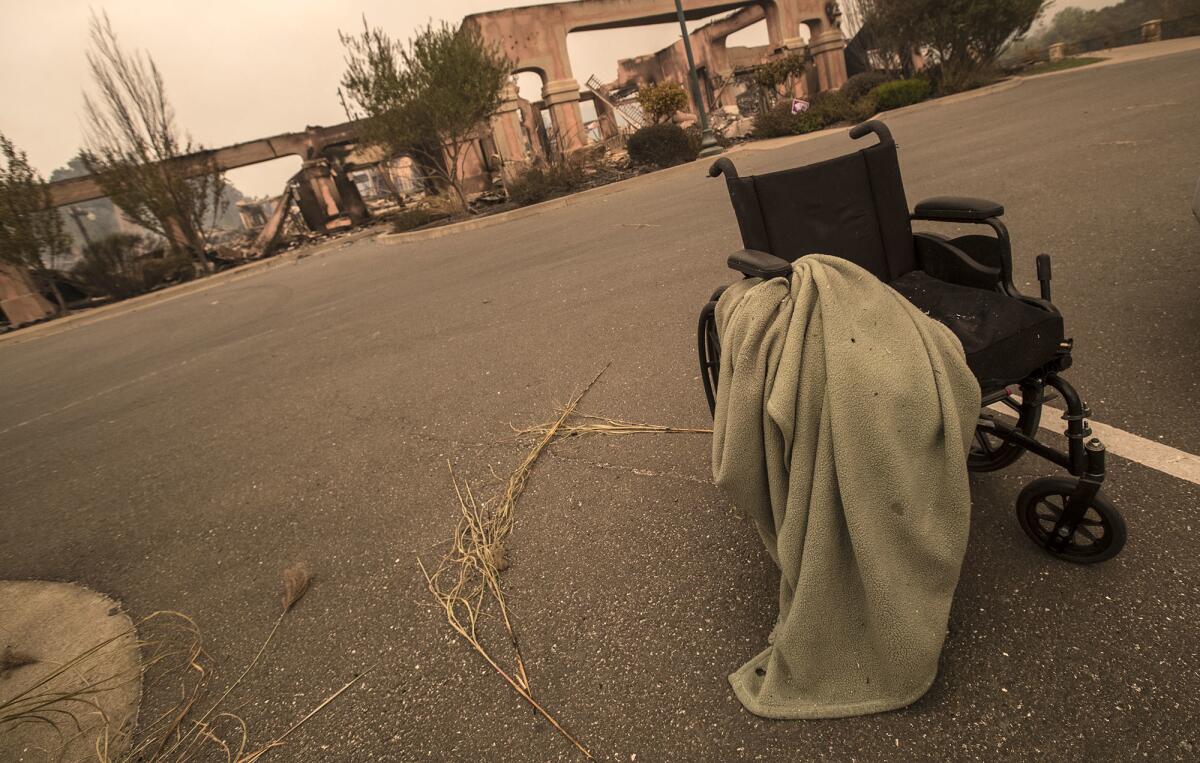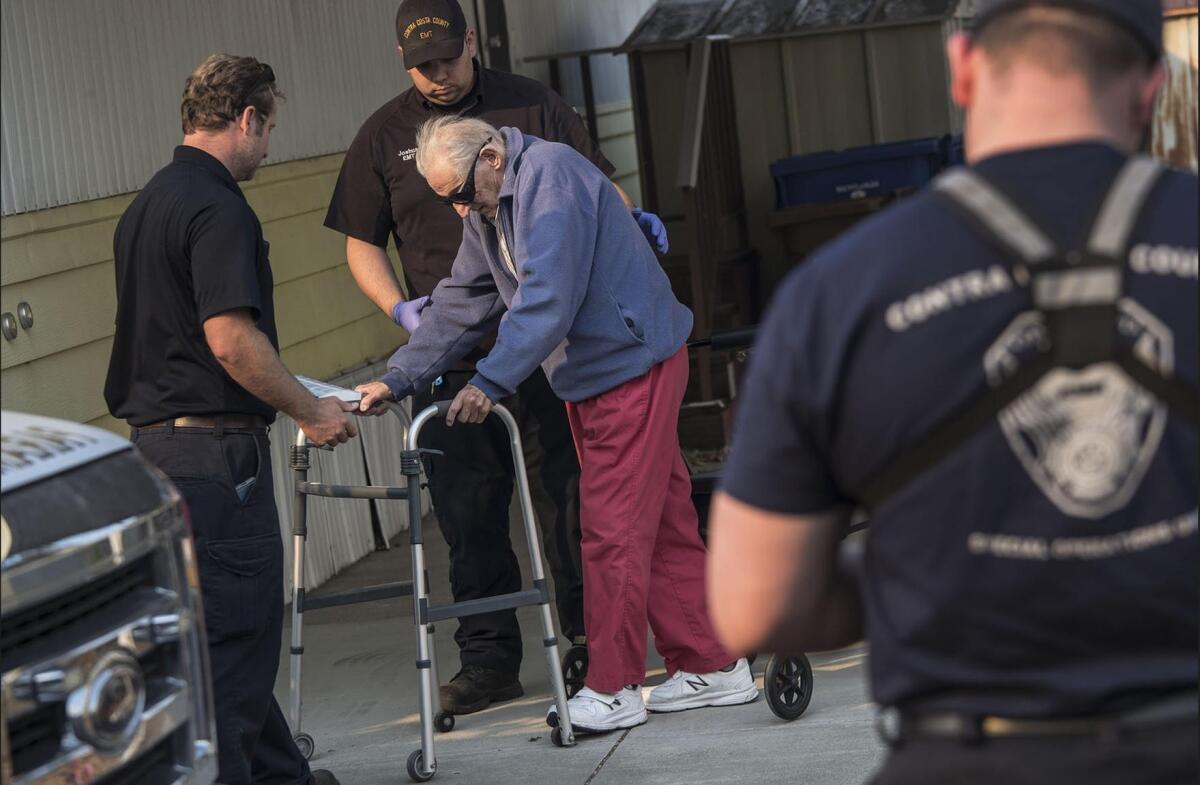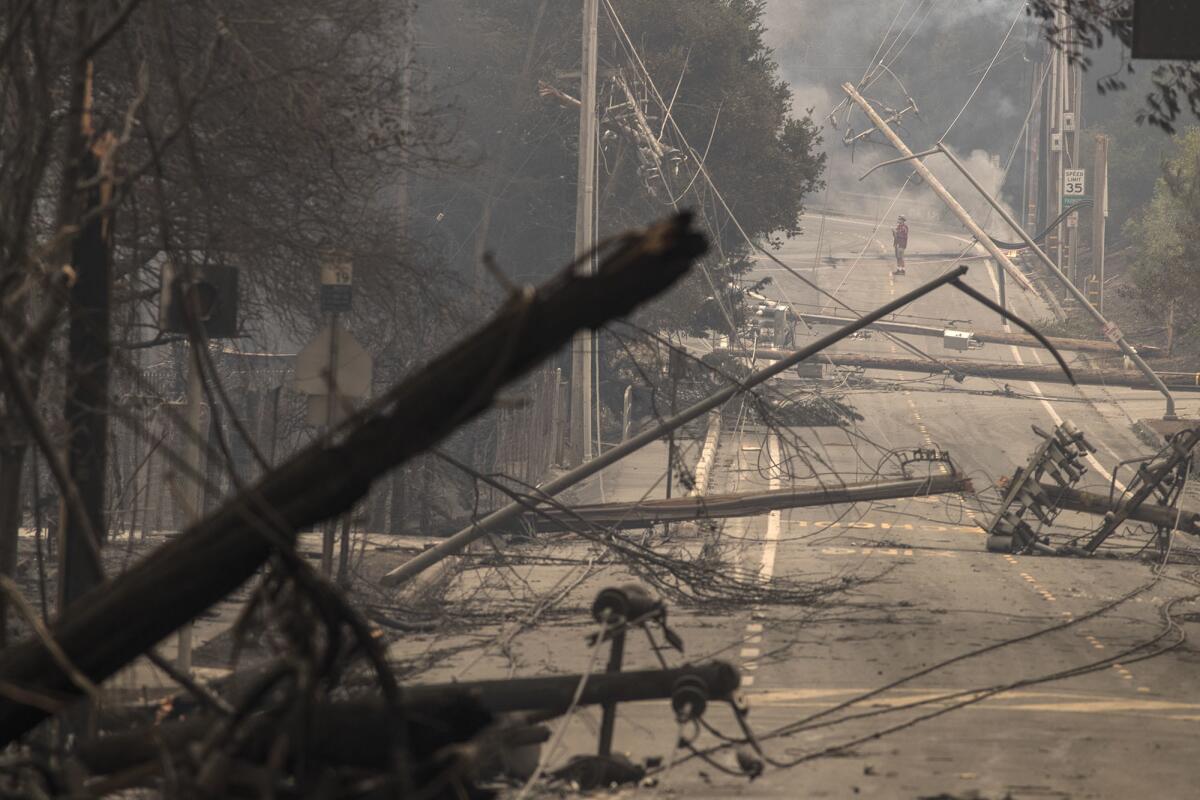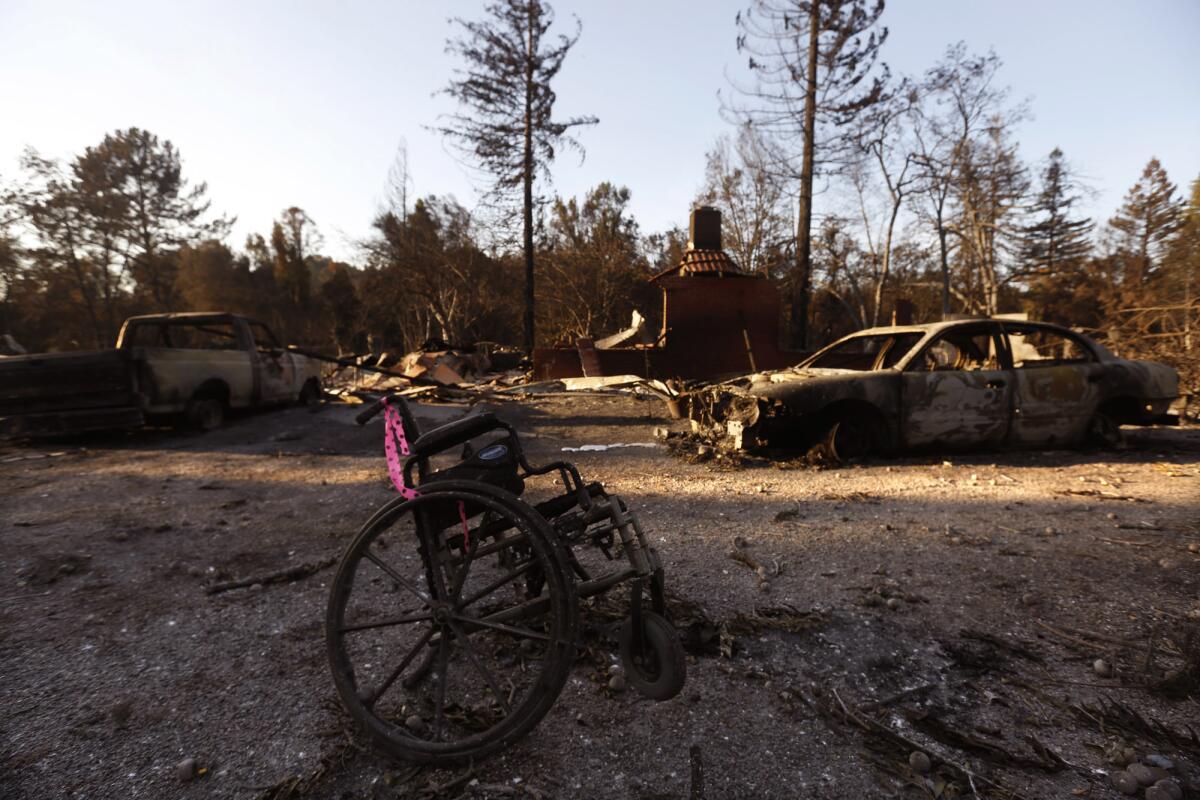Wildfires stressed wine country’s healthcare system, creating a crisis and a warning for future
- Share via
Reporting from SANTA ROSA, Calif. — Dr. Scott Witt kept close behind the ambulance carrying the newborns. On his motorcycle, he drove over and ducked under downed power lines. He swerved around embers blowing onto the highway.
Sutter Santa Rosa Regional Hospital, where Witt oversees the neonatal intensive care unit, was being evacuated Oct. 9 because of wildfires that would become the deadliest in California history.
But Witt couldn’t call the doctors who would be caring for the babies because there was no power. The physicians at the other hospital also had no way of accessing Witt’s medical records online to know what treatment was needed.
“I knew if I didn’t leave then, there would be no way I could take care of the babies,” he said.
As the blaze grew feet away, Witt tailed the ambulance through smoke and debris.
The Northern California wildfires created what some described as an unprecedented healthcare crisis that has served as a wake-up call in the region. Not only were two major hospitals evacuated hours into the disaster, but the chaos continued for days after.

Thousands of people were displaced and staying in shelters, many without their medicines. The fires left clinics burned, or evacuated for days. Pharmacies struggled to fill prescriptions. Nursing home patients waited on cots in shelters, without oxygen tanks or their caregivers. Doctors and nurses also lost their homes.
Some of the problems were unique to the wine country fires, which raced from open space into the hearts of communities, killing more than 40 and destroying more than 5,000 homes, many in Santa Rosa.
But the damaging effects on the healthcare system could easily be repeated during other natural disasters, such as earthquakes causing widespread destruction in the Los Angeles region and the Bay Area.
Officials in Santa Rosa said the fires showed the success of some of their medical emergency planning, but also exposed gaps in the healthcare system’s response.
“It’s going to happen again. There’s going to be another fire, there’s going to be another earthquake, there’s going to be another flood and ... we absolutely have to get better at this,” said Chad Krilich, chief medical officer for St. Joseph Health in Sonoma County.

Hitting close to home
In the dead of night, one of the wildfires forced the evacuation of Sutter Santa Rosa and Kaiser Santa Rosa hospitals. Patients were wheeled out and hooked up to IVs, while flames approached. Staff concerned about power outages affecting the elevators helped fragile patients walk down the stairs. Some were put on city buses to their next destination.
Kelsey Claybrook, a security officer for the Sutter hospital, burned his jacket as he tried to put out spot fires outside the hospital with a bucket of water and a fire extinguisher.
“It was like a whack-a-mole, you would pour water, it would come back up,” he said.
The hospitals were safely evacuated and avoided severe damage, but the fires reduced nearby neighborhoods to ash. The medical centers in the region that remained open last week treated not only the patients of the evacuated hospitals, but also people suffering from burns and smoke inhalation.
“I’ve been at this a long time and ... I’ve never seen anything like this, in terms of the magnitude of the response that was necessary,” said Sarah Krevans, chief executive of the Sacramento-based Sutter Health system.
Health workers weren’t spared from the fire’s damage. The homes of many county employees, doctors and nurses were in the blaze’s path, complicating the early response to the fire.
When trying to roll out emergency operations at Sonoma County government offices early that Monday morning, some staff couldn’t be contacted or called in because of downed power lines, said health department spokesman Scott Alonso. They had to scramble for replacements for some roles that needed to be filled, he said.
“We train in this, we practice it, and when a disaster strikes, sometimes it’s like a training, but often it’s not,” Alonso said.
At St. Joseph’s Petaluma Valley Hospital and Santa Rosa Memorial Hospital, planning was challenging as the fires continued throughout the week. A change in winds could mean a new group of staff members needed to leave work to pack up their belongings and evacuate their homes, Krilich said.
“It would’ve been really nice to be able to have a crystal ball if you could know what area would be impacted,” said Krilich, who was evacuated from his home. “Is that going to hit the lab, or anesthesiology, or is that going to hit housekeeping?”

Witt made it to Santa Rosa Memorial safely with the babies as dawn broke on Monday. He then met up with his wife and children, who’d been pushed from their home by the threat of fire earlier in that morning.
Hours later, he learned their Santa Rosa neighborhood, Fountaingrove, had been decimated by the fire. His family hadn’t grabbed much on their way out because they thought the evacuations were a precaution.
The doctor hopped on his motorcycle, again scooting around felled power lines.
“I wanted to see for myself,” he said. “It was just rubble and ashes.”
Making it through the week
The aftermath of the fire presented countless challenges for the rest of the healthcare system.
Many residents struggled to breathe because of the smoky air. Tens of thousands of people were evacuated into schools and fairgrounds across the region.
“Each shelter had to figure out how do you manage these almost MASH-unit trauma centers,” said Jason Cunningham, chief medical officer for the West County Health Centers.
When Dr. Deborah Donlon arrived at Elsie Allen High School in Santa Rosa on Monday, many frail nursing home patients were sitting in folding chairs in the gym.
Donlon rushed to one of the Santa Rosa Community Health clinic sites nearby, where she works, to grab medicines that would be most useful, like aspirin and inhalers.
She remembers standing in the pharmacy thinking, “I wish I had a list that said, ‘In case of huge fire that wipes out a third of your community, take these medications,’” she said. “Our usual way of operating was completely out the window.”
Like many medical facilities that stayed open last week, Santa Rosa Memorial was inundated by people who wanted to help patients, both from the community and from outside. However, some had trouble getting privileges to work at the hospital and it was difficult to teach the system’s electronic health record system to those who did, Krilich said.
Kevin “Kip” Thomas, director of the healthcare emergency management program at the Boston University School of Medicine, said that’s a downside of not having medical records accessible to all doctors, no matter who they work for. Medical facilities in Northern California have planned for wildfires and evacuations, but it’s unlikely they envisioned so many facilities would be affected at the same time and that they would need access to so many other hospitals.
“The big challenge here is the magnitude of this,” Thomas said. “That’s definitely something that hasn’t had to be addressed to this level before.”

How do I get my medicines?
With so little time to flee their homes, many evacuated without their medicines.
Safeway pharmacists traveled from other parts of the state to help the stores that were filled with patients and brought medicines with them to keep up with the extra demand, said the company’s Northern California pharmacy director Narayanan Ramachandran.
“I don’t think we were ready, but we definitely reacted,” Ramachandran said. “Almost every counter had somebody there to take care of people, and honestly we needed everybody there.”
On Monday, shortly after Gov. Jerry Brown declared a state of emergency because of the fires, California’s pharmacy board instituted a disaster protocol that allows pharmacists to dispense medicines without prescriptions. It instructs them to use their best judgment to help patients.
But doctors in the North Bay said many patients still showed up at their offices unable to get vital prescriptions like seizure medications. Many encountered hurdles with insurance companies, which pharmacists typically had to call individually to approve the refill requests. Some doctors began standing outside of pharmacies to write prescriptions for needy patients.
Richie Duenas, a pharmacist and owner of Mercury Pharmacy — which has one location in Vallejo and one in Fairfield, near the Napa fires — said the fire made him concerned about the durability of pharmacy supply chain.
Medicines are delivered by UPS and Fed-Ex. But the delivery worker dropping off medicines in the days after the fire was suffering from the smoke, even while wearing a mask to protect his lungs, Duenas said.
“He said to me, ‘I don’t know how long I can do this,’” Duenas said.
Duenas said he’s considering stockpiling medicines, but many have a short shelf life.
“This kind of exposed a big piece of what we can do to make sure people get healthcare and medicine,” he said. “You go to the doctor. What do you get? A prescription. So how do you get people their meds in times of emergency?”
Twitter: @skarlamangla
ALSO
Residents advised to close windows after fire erupts at Chevron oil refinery in El Segundo
How Washington’s formula for fighting wildfires makes them worse
New fires in Sausalito, Santa Cruz and Dublin force evacuations
More to Read
Sign up for Essential California
The most important California stories and recommendations in your inbox every morning.
You may occasionally receive promotional content from the Los Angeles Times.











